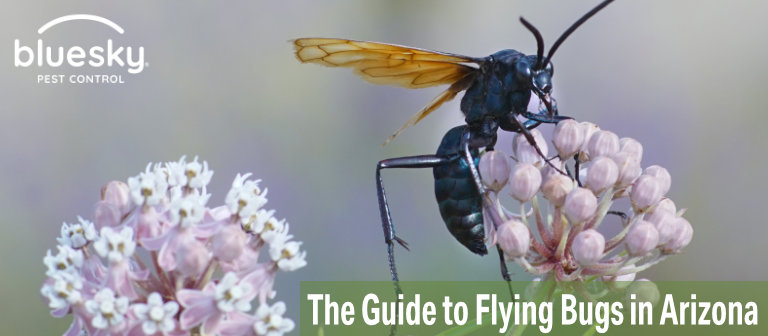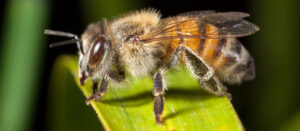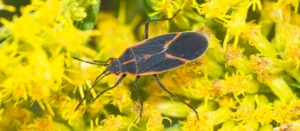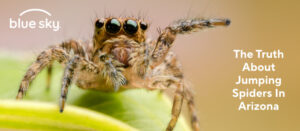$50 OFF New Residential Customers. Learn more
The Guide to Flying Bugs in Arizona & Which Ones to Look Out For

Flying bugs in Arizona are a fairly common sight, and if you’ve spent any time here, you’ve probably noticed them buzzing around. In this post, we’re going to break down some of the most prevalent flying bugs you’ll encounter in Arizona and what you need to know about them. From pesky mosquitoes to moths that seem to come out of nowhere, we’ve got you covered. Let’s dive in and figure out which bugs to watch out for and how to deal with them.
If you need pest control for flying bugs or any other type of pest in the Phoenix area, we can help you! We have offices in Phoenix and Gilbert that make it easy for us to serve the entire metro area including Avondale, Glendale, Peoria, and all the way out to Surprise.
Flying Bugs in Arizona
Flying insects in Arizona are just part of the package when you’re living in or visiting the desert. The warm climate and variety of habitats make it a bug paradise. Whether its bees buzzing around during the day or moths fluttering at night, you’ll find these flying critters just about everywhere. They don’t just stick to the wild areas either; they’re just as happy hanging out in urban spots like Phoenix as they are buzzing around in the middle of nowhere. These bugs can be both fascinating and a bit annoying. They’re crucial for things like pollination and keeping the food chain in balance, but they can also drive you nuts, especially when it gets hotter, and they seem to multiply overnight. Getting to know how these insects operate and finding ways to live with them can make your time in Arizona a lot more enjoyable, whether you’re here for the long haul or just visiting.
Common Types of Flying Insects in Arizona
- Mosquitoes: Mosquitoes don’t need much of an introduction. They are slender insects with long legs and a proboscis used for feeding. They range in size from about 1/8 to 3/8 inch. These pesky bugs are more than just a nuisance; they play a crucial role as pollinators and serve as a food source for other animals. However, their bites can be irritating and, and sometimes dangerous, transmitting diseases like West Nile virus, making them a significant health concern in Arizona.
- Bees: Recognizable by their fuzzy bodies adorned with black and yellow stripes, bees are about 1/2 to 3/4 inch in size. These insects are essential for pollination, helping plants and flowers reproduce. While generally not aggressive, bees often sting if they feel threatened, which can be a huge concern for individuals with allergies.
- Social Wasps: Wasps are easily identified by their slim bodies and narrow waists, many with distinctive black and yellow markings. They measure about 1/2 to 1 inch in length. Wasps contribute to the ecosystem by controlling pest populations, as they feed on other insects. However, they can be quite aggressive, and their stings are painful, posing a risk of allergic reactions.
- House Flies: House flies are common visitors in homes, characterized by their gray bodies with four dark stripes on the thorax, measuring about 1/4 inch in size. These flies play a role in decomposing organic matter but are notorious for spreading diseases by contaminating food and surfaces with bacteria.
- Moths: Moths come in a variety of colors and patterns, typically duller compared to butterflies. Their size ranges widely, with some having wingspans of several inches. Moths are important pollinators and provide a food source for many predators. The good news is, they don’t bite or sting and are generally harmless to humans.
- Butterflies: Butterflies are known for their brightly colored wings with intricate patterns, ranging in size from 1/2 inch to several inches in wingspan. Besides being beautiful, they are vital pollinators and indicators of a healthy environment.
- Dragonflies: Dragonflies have long bodies, large transparent wings, and compound eyes. They range in size from about 1 to 4 inches. These insects are beneficial as they help control mosquito populations by preying on them. Dragonflies don’t bite or sting humans and are considered harmless.
- Cicadas: Cicadas are bulky insects with large, transparent wings and prominent eyes, measuring about 1 to 2 inches. Despite their loud buzzing sound, these bulky bugs pose no danger to humans.
- Gnats: Gnats are tiny insects with delicate bodies and long legs, about 1/8 inch in size. They serve as pollinators and decomposers in the ecosystem. Some species of gnats bite, causing minor skin irritation, but most are harmless.
- Horse Flies: Horse flies are large insects with robust bodies and colorful eyes, ranging from 1/2 to 1 1/4 inches. They are part of the food web, serving as prey for birds and other animals. However, horse flies are known for their painful bites and can transmit diseases to livestock, making them a concern for both humans and animals. Luckily, these large flies are uncommon in urban areas preferring to live in rural areas and around cattle or horses upon which they feed.
Large Flying Bugs in Arizona
You might spot some pretty impressive large flying bugs throughout Arizona that add a bit of character to the local scenery. Take the giant desert cicada, for example, which emerges during the scorching summer months. These bugs are fascinating not just because of their size, but because of their loud, buzzing chorus that fills the air at dawn and dusk. This sound is an iconic backdrop to Arizona’s hot season and a signal of the ecosystem’s cyclical nature.
Another noteworthy mention is the tarantula hawk wasp. This large, metallic blue wasp with bright orange wings is hard to miss and even harder to forget once you know its story. Known for hunting tarantulas, these wasps have one of the most painful stings in the insect world, though they rarely sting humans unless provoked. Their presence highlights the diverse and sometimes startling interactions within Arizona’s desert ecosystems. Seeing these large bugs up close can be a reminder of the unique and vibrant natural world that thrives in the harshest of climates.
Small Flying Bugs in Arizona
The Arizona landscape is home to a variety of small flying bugs that add to the intricate web of the ecosystem. One such insect is the desert midge. These tiny, almost invisible bugs are known for their swarming behavior, particularly around water sources at dusk and dawn. Although they don’t bite, their presence can be a minor annoyance during outdoor activities. Interestingly, midges play a crucial role in the food chain, serving as a vital food source for fish and birds.
Another small yet fascinating flying bug in Arizona is the fruit or vinegar fly. These tiny insects are attracted to fermenting fruits and vegetables and are commonly seen in kitchens and gardens. While they might seem like mere pests, vinegar flies are actually essential for decomposing organic matter. They help break down rotting fruits and vegetables, recycling nutrients back into the soil and aiding in the process of composting. Their presence is a reminder of the natural cycle of decay and regeneration that keeps ecosystems healthy.
Lastly, Arizona is home to a variety of small, colorful hoverflies. Often mistaken for bees or wasps due to their bright yellow and black stripes or metallic green color. Hoverflies are harmless to humans. These small insects are excellent pollinators, visiting flowers to feed on nectar and pollen. Hoverflies are also beneficial in controlling aphid populations, as their larvae are voracious predators of these plant-damaging pests. Their dual role as pollinators and pest controllers makes them invaluable to gardens and natural landscapes.
Black Flying Bugs in Arizona
Black flying bugs bring their own unique touch to the desert ecosystem. One very notable insect is the black blister beetle. These beetles are commonly seen around gardens and fields in Northern Arizona, especially during the warmer months. Larvae of this beetle feed on grasshopper eggs. In the Phoenix area, the large black and orange master blister beetle is common on brittlebush in the spring. What makes them particularly interesting is their defense mechanism. When threatened, they release a chemical called cantharidin, which can cause blisters on human skin. Despite this, some species of blister beetles play a significant role in controlling pest populations by feeding on harmful insects, contributing to the natural balance in agricultural areas.
Another fascinating black-flying insect in Arizona is the black soldier fly. Often mistaken for a wasp due to its sleek, dark appearance, the black soldier fly is entirely harmless to humans. These flies are nature’s recyclers, with their larvae breaking down organic waste and compost. This process not only helps reduce waste but also enriches the soil with valuable nutrients. Black soldier flies are increasingly being used in sustainable waste management practices, highlighting their unique contribution to environmental health. Some countries even farm them as human food!
Lastly, the large black carpenter bee is a common sight in Arizona, buzzing around wooden structures. Unlike other bees, carpenter bees excavate tunnels in wood to create their nests, which can sometimes be a concern for homeowners. However, these bees are important pollinators, especially for native plants. Their role in the ecosystem goes beyond just pollination. Their nesting behavior helps aerate wood, contributing to the natural decomposition process. Despite their intimidating appearance, carpenter bees are generally non-aggressive and more interested in their solitary work than in humans.
Green Flying Bugs in Arizona
Green flying bugs add a splash of color to the desert landscape, each contributing uniquely to the environment. The green stink bug is a common sight with its bright green, shield-shaped body. Known for the unpleasant odor they emit when disturbed, these bugs often make their home in gardens and fields. While they can be a nuisance to farmers due to their plant-feeding habits, they also serve as a vital food source for birds, spiders, and predatory insects, playing an essential role in the local food web.
Adding to the diversity of green flying bugs is the green fruit beetle, often called the fig beetle. These large beetles, with their iridescent green bodies, are commonly seen around ripening fruits. Despite their size and the loud buzz they produce when flying green fruit beetles are harmless to humans. They play an important role in breaking down overripe and decaying fruits, aiding in composting and nutrient cycling in the soil. Their activity helps maintain the health of gardens and orchards and contributes to the balance of nature in Arizona.
How To Deal With Unwanted Flying Bugs in Arizona
Dealing with flying pests in Arizona can be a challenge, particularly mosquitoes, which are among the most prevalent and annoying. Here are some tips to help manage mosquitoes and other common flying bugs in Arizona:
Mosquitoes
- Eliminate Standing Water: Remove any sources of standing water around your home, as these are breeding grounds for mosquitoes.
- Use Repellents: Apply mosquito repellents containing DEET (30% or more), picaridin, or oil of lemon eucalyptus when spending time outdoors.
- Install Screens: Make sure windows and doors have screens to keep mosquitoes from entering your home.
- Mosquito Traps: Consider using mosquito traps in your yard to reduce the population.
- Mosquito Treatments: Fogging for mosquitoes every month can drastically reduce mosquito populations.
Black Flies and Horse Flies
- Fly Traps: Use fly traps to capture and reduce the number of flies around your home or livestock areas.
- Repellents: Apply fly repellents on exposed skin and clothing.
- Clean Livestock Areas: Keep areas where livestock are kept clean and dry to minimize fly populations.
Blister Beetles
- Hand Removal: Regularly inspect your garden and remove blister beetles by hand.
- Insecticidal Soap: Use insecticidal soap to treat plants and control beetle populations.
The Guide to Flying Bugs in Arizona Conclusion
Arizona’s flying bugs, from tiny gnats to large dragonflies, play vital roles in the ecosystem. Blister beetles use unique defense mechanisms. Green lacewings help control garden pests, while vibrant butterflies pollinate flowers. Each insect contributes to the desert’s natural balance. However, certain flying bugs can become threatening and can cause severe damage. At Blue Sky Pest Control, we understand the ins and outs of Arizona’s flying insects. We’re experts when it comes to mosquito control and can handle any pest problem you might face. Whether it’s a residential or commercial property, we can create a custom-tailored plan to keep your space bug-free. Trust us to help you maintain a comfortable and pest-free environment.
Related Posts

Killer Bees in Arizona? Understanding Africanized Bees and How to Coexist Safely
You’ve likely heard the term “killer bees” used to describe Africanized bees in Arizona, but did you know this nickname…

Red & Black Intruders: Meet Arizona’s Boxelder Bugs
Boxelder Bugs in Arizona If you’ve ever stepped outside and spotted a cluster of black-and-red bugs crawling on your porch…

Jumping Spiders in Arizona: Harmless or Hazardous?
Jumping spiders in Arizona might be small, but they can certainly give you a big surprise when they suddenly appear…